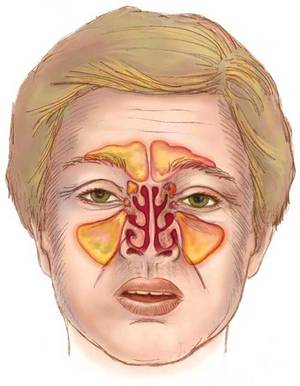Sinus infections generally start as a common cold, leaving one feeling tired and achy. You are coughing, blowing your nose and trying to stay ahead of your headache. After a few days, all these symptoms seem to worsen and you can not feel relief from taking medicine. Your face feels very painful and congested. This is the tell-tale sign that the bacteria has migrated into your sinuses and caused a nasty infection.
You skull contains 4 sinus regions. A sinus is simply a hole inside the facial region of your skull. The sinuses each have openings to allow air to flow as well as fluid to drain. There are also openings into the nasal cavity from the sinuses to allow for ventilation. When the fluid from your nasal cavities moves into your sinuses you can feel great pressure. Often the fluid will become trapped once the opening is plugged. This creates pressure and pain. The four sinuses are: frontal, maxillary, ethmoid and sphenoid. The frontal sinus is located just over your eyes, about at your eyebrow level. The maxillary sinuses are located on the inside of your cheekbone. The ethmoid sinus lies just behind your nose, between your eyes. And the sphenoid sinus is behind the ethmoid sinuses, just behind your eyes.
Sinus infections are caused by a virus or bacteria that have entered your nasal system and eventually spread to your sinuses. In a healthy person, the body will fight the virus and prevent it from entering the sinuses, but if a person is suffering from other symptoms the body is weakened and the bacteria get ahead of your body. Some people suffer from chronic sinus infections. Chronic sinus infections are ongoing infections that seem to have no distinct cause. They may be caused by an abnormality in the anatomy of your sinuses, acute allergies, or growths in your nose known as polyps.
The symptoms of a sinus infection are similar to that of any upper respiratory infection. Some tell-tale symptoms of a sinus infection are painful headaches, pain in your face when you touch it, swelling of your eyes or pressure in your eye cavities, ear pain, neck pain, fever, and a cough.
Your doctor will need to examine you to conclude you have a sinus infection. An X-ray of the skull can determine is there is fluid trapped in your sinuses. A CT may also be done to see a better view of each sinus. If you suffer from recurrent or chronic sinus infections, a doctor may prescribe surgery to obtain a biopsy of the fluid or cells that are contained in your sinus.
Treatment usually consists of antibiotics if bacteria are the cause. If the infection is caused by a virus, your doctor will most likely prescribe heavy strength decongestants or expectorants to thin the mucous and allow your sinuses to drain. Pain relievers may also be used to control the pain that is associated with a sinus infection. Nasal sprays may be used to control congestion and steam vaporizers can be very helpful to aid in decongestion of your sinuses. Drinking plenty of fluids will help your body stay hydrated and cope from the illness.
If a sinus infection is allowed to spread, complications may develop. In very severe and rare cases, the brain may become infected and lead to damage of the sensitive brain tissue. More common complications include: ear infections and pneumonia.
Be sure to see your doctor if you think you are suffering from a sinus infection. Proper treatment will result in a rapid recovery. Sinus infections may be very painful, but are generally rapidly healing and before long, you will be feeling back to your normal, healthy self!
